
Share Your Favorite Photo



The Rio Grand Nature Center is a state park in Albuquerque, located where Candelaria NW ends at the Rio Grande. It has been funded by the state of New Mexico since 1982. You enter the park on a foot path following along a row of old cottonwoods, golden at this time of year. The path leads you into the tunnel entrance of the visitor center, which is open seven days a week from 10:00am–4:00pm. The grounds are open longer, from 8:00am-5:00pm. The center is available to the public for meetings and other special events.
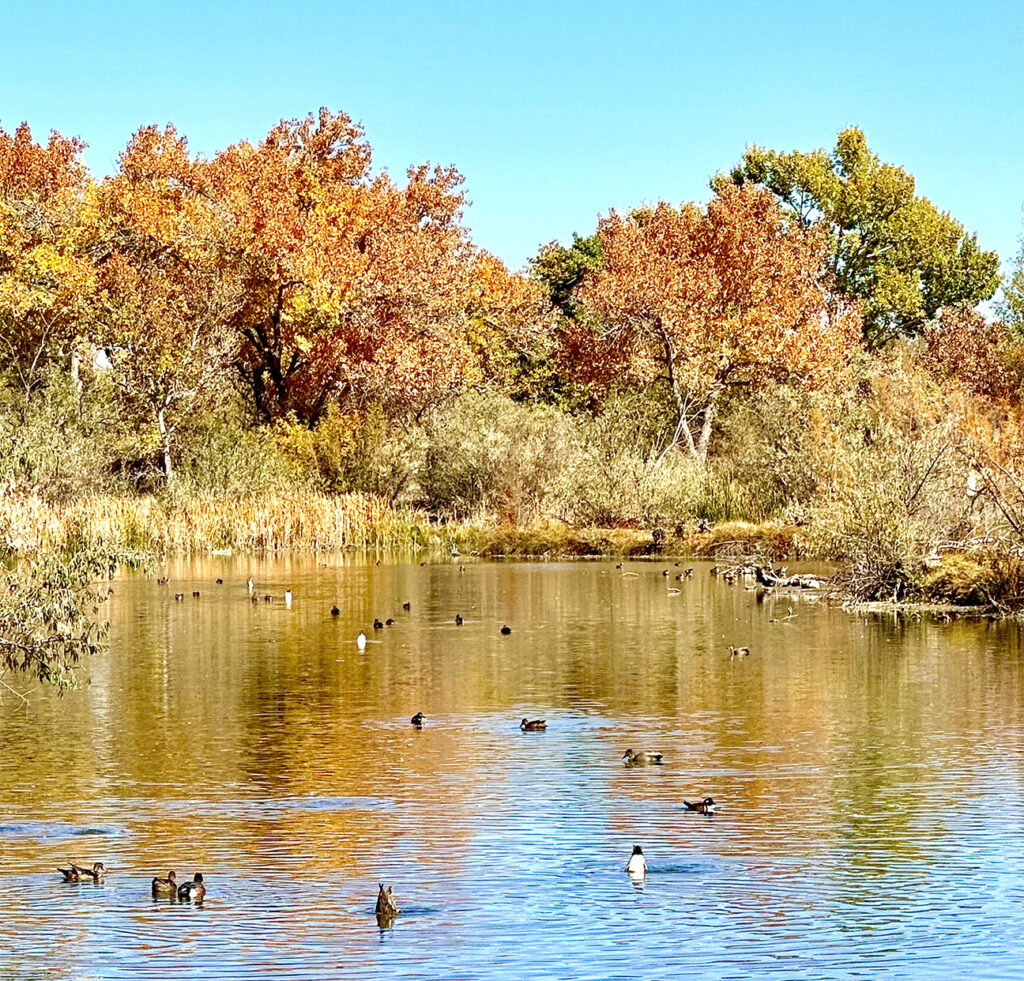
The exhibits at the visitor center challenge the visitor with questions. For example, the fossil exhibit queries: “Why are the same fossils found on the Sandia mountaintop as found thousands of feet below in the Rio Grande Valley?” Another exhibit demonstrates how a marsh evolves into a meadow. Did you know that there are about 6,000 feet of sand and gravel deposits under Albuquerque? There are educational exhibits of habitats in the bosque, plus displays of birds, trees, and wetlands. There are also viewing windows of the pond next to the center where many turtles and ducks swim.
Several short walking trails provide sights of local plants and birds. These also connect to longer trails such as the Paseo del Bosque and the Aldo Leopold Trail. Aldo Leopold established the first wilderness area in a US Forest in the Gila area and subsequently moved to Albuquerque. Here he became active in the Chamber of Commerce and championed the idea of preserving the bosque along the river. The Aldo Leopold Trail goes to Montaño Road and has interpretive signage.
Each Saturday and Sunday morning, there are guided bird walks on the nature center grounds. Currently they are averaging sightings of around 30 different species, with 200 species seen over the full year. A special nature walk is coming up on November 11 at 10:30 a.m. with a naturalist. People must register for both the weekly guided bird walks and upcoming nature walk by calling the center at 505-344-7240. Admission to the Center is free, but there is a $3.00 parking fee.
VALLE DE ORO, a National Wildlife Refuge
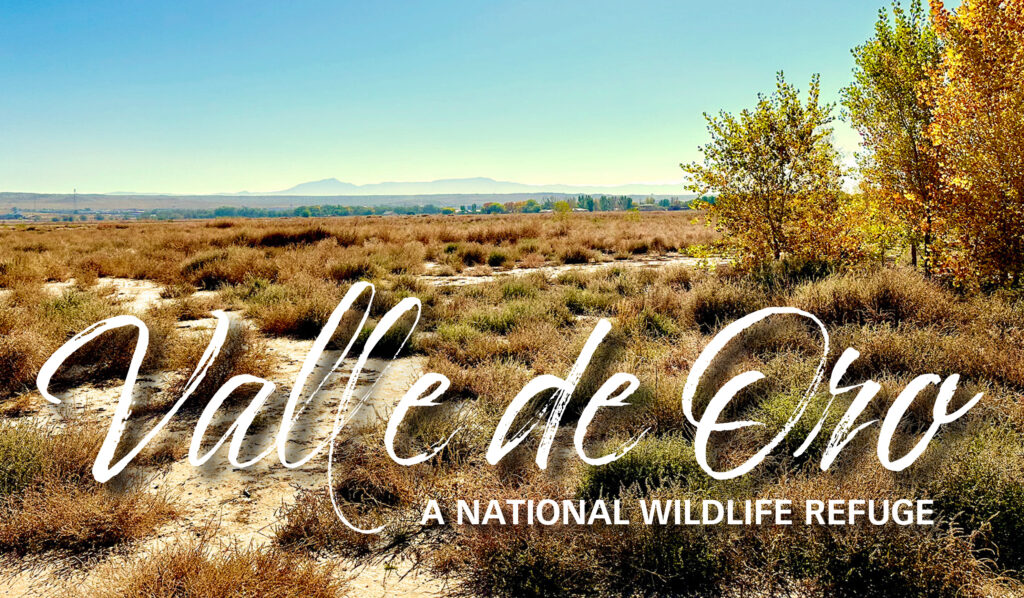
Two-and-a-half miles south of Rio Bravo on 2nd Street SW in Albuquerque, one of the few urban National Wildlife Refuges in the US is thriving. This 570-acre refuge was once a dairy farm. When it was put up for sale, people in the Mountain View community of the South Valley came together to form the Friends of Valle de Oro. Together with the Tiwa People of Isleta Pueblo, for whom the land is their traditional, unceded homeland, they advocated for it to become a public space. They wanted to have a space where other species could flourish in the midst of humanity, as a way to cooperate with our wild neighbors. The project began with a survey of 500 households in the area, which was used to make a strategic plan. When Valle de Oro National Wildlife Refuge was established in 2012, the staff and volunteers built on the plan to develop a vision of a Refuge that would meet urban environmental and ecological needs in many ways. They continue to make the refuge a creative work in progress.
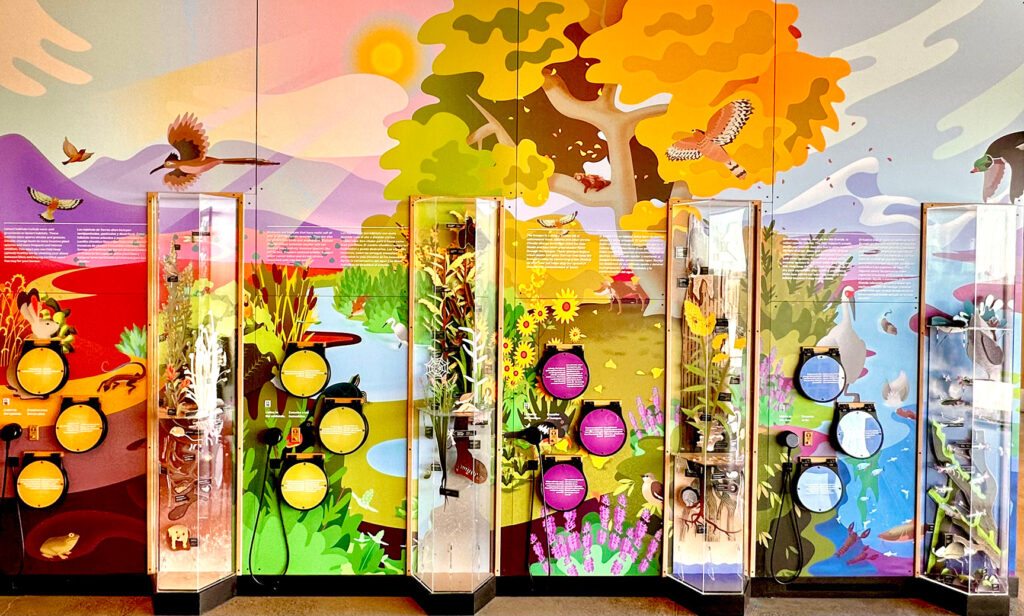
Most of the visitor center is comprised interactive exhibits. A visitor can choose short videos on various topics such as ‘community gardening,’ ‘night visitors’ (beavers), ‘nighttime and mosquitos,’ ‘searching for porcupines,’ etc. There are also viewing boxes including an orb spider and its web and pill bugs working to decay leaves. You can even feel the difference between the skin of a frog and a toad. The exhibits and videos are low enough to be accessible to both children and adults. The center also has a library with books on environmental justice for both children and adults, a gift shop, and a meeting room.
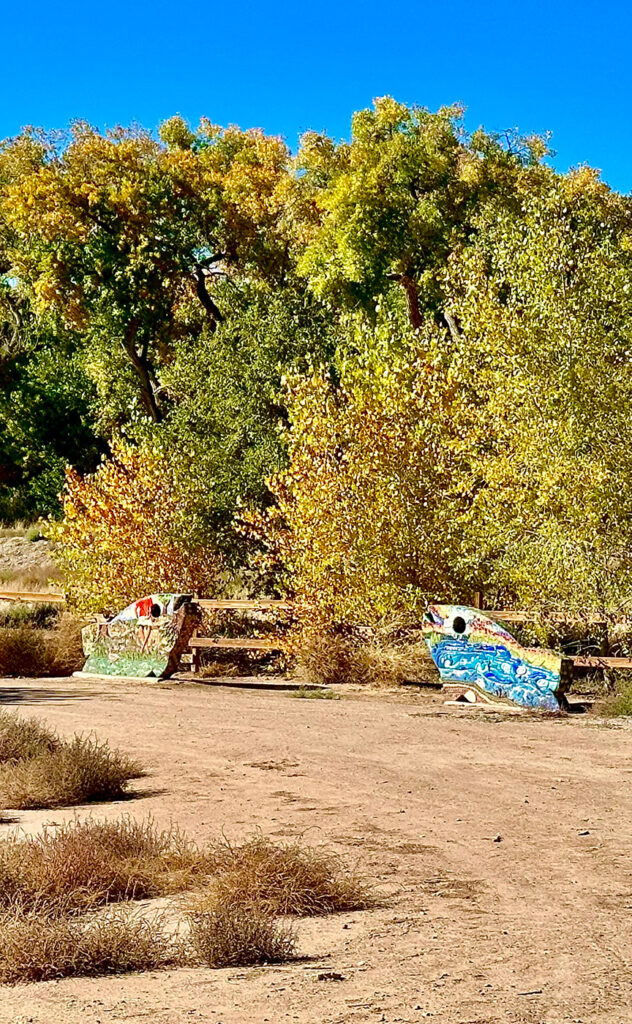
Outdoor educational opportunities include a pond with signage behind the center and trails to explore farther. Part of the Bosque Trail is currently closed due to habitat restoration and to build a stormwater swell. This area is also part of a future plan to have five different wetlands. During peak spring, summer, and fall months, there is a shuttle to take you from the visitor center farther into the bosque.
The Albuquerque Backyard Habitat program is a major project of the center. This program has a free detailed workbook which is easy to download. It guides the reader in learning which plants in our region are most likely to attract birds, other animals, and insects and how to support their lives year-round. After a residence or commercial space has signed on to develop a refuge area, it is visited by staff, given additional guidance, and then approved as a Backyard Refuge. The space is given a sign and re-qualified on an annual basis. So far, across the county over 100 acres have qualified as urban refuges. The goal is to match new backyard refuge acreage with that of the Valle de Oro refuge, i.e., 570 acres. In spring and fall, the center hosts a Backyard Refuge workshop. Consultants on native plants, water harvesting, pollinator habitats, and more are present to answer questions, and there is a seed exchange.
There is no admission fee. This is an opportunity to enrich both yourself and the community as you develop your own Backyard Refuge.
This 57,000-acre National Wildlife Refuge was established in 1939 when it was noticed that few sandhill cranes were using this traditional winter flyway. The Refuge began making food available as a way to support the birds. This has evolved into multiple marsh ponds,15 miles of driving roads, hiking trails, a visitor center, and habitat for many birds, mammals, and insects. Because of its location along the Rio Grande, water can be directed through channels and used to grow marsh crops such as millet and bullrush and, in the grain fields, alfalfa, wheat, and clover. This system makes the area a rich source of food for wintering birds.
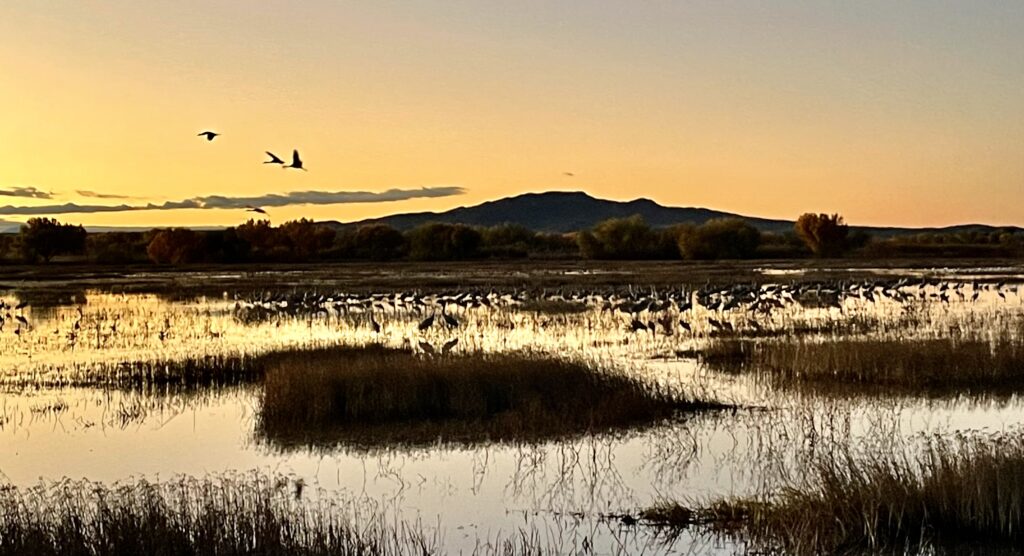
Bosque del Apache is best known for hosting the winter feeding grounds of the Sandhill Crane. In recent years, about 10,000 cranes have wintered here. Since they can fly up to 500 miles a day, it is no problem to come from their summer homes in Wyoming and Montana. They spend the night standing in shallow water or on patches of marsh, safe from predators, and fly out to forage first thing in the morning. There is fossil evidence that this unique bird has been around for the past nine million years, giving it the longest history of any other current bird species.
A festival to honor the crane is held annually; this year it will be from December 6–9. The Friends of the Bosque website is full of nformation on the available lectures, tours, and transportation. Beside the cranes, one may also see some of the 20,000 Ross’s and Snow Geese, eagles, 20+ species of ducks, mule deer, coyote, muskrat, javelina, and porcupine.
Bosque del Apache’s history is more than birds. The Piro Pueblo People once lived on this land. A Pueblo village was on land that is now known as the Little San Pascual, a 20-acre parcel adjacent to the Refuge that is one of three nearby federally-designated Wilderness. This Pueblo village once had 1,500 rooms, and it is thought that about 7,000 Piro People lived in the 60-mile stretch along the river in what is now Socorro County. With the arrival of the Spaniards, the Piro People were beset with new illnesses and skirmishes. By the time of the Pueblo Revolt of 1680, the Piro People were dead or scattered and never returned to the area.
There is no fee to visit the museum, but it costs $5.00 to drive through the Refuge and the Festival’s lectures and tours require a registration fee. The Bosque del Apache is a unique New Mexican experience, rich in history and habitats. Enjoy!